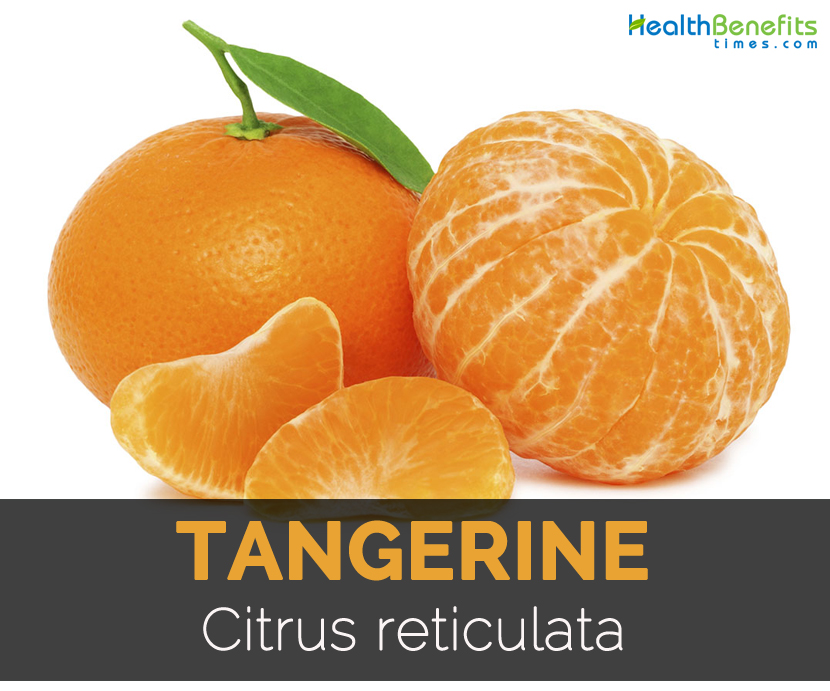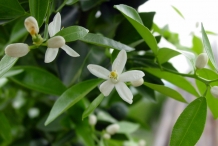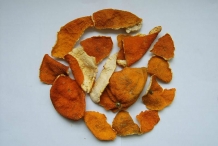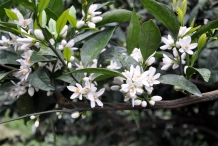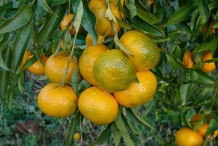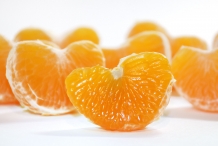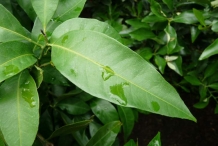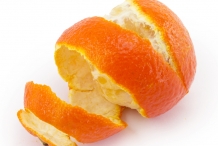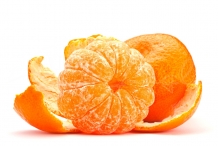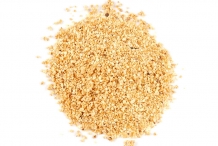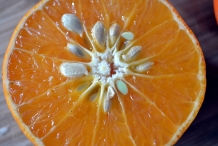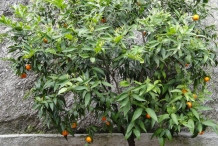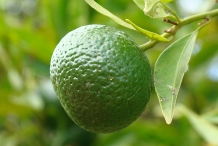| Tangerine Quick Facts |
| Name: |
Tangerine |
| Scientific Name: |
Citrus reticulata |
| Origin |
It is originated in southwestern China or northeastern India. Tangerine is native to south east China and or south Japan. |
| Colors |
Light or deep orange |
| Shapes |
Oblate or pyriform, 5 to 8 cm in diameter |
| Calories |
103 Kcal./cup |
| Major nutrients |
Vitamin C (57.89%)
Carbohydrate (20.01%)
Vitamin B6 (11.69%)
Vitamin A (9.43%)
Vitamin B1 (9.42%)
|
| Health benefits |
Reduce fever, Prevention of colds and flu, Cancer prevention, Healing process, Healthy cholesterol level |
Citrus reticulate is also known as Mandarin, Mandarin orange, Satsuma, Mandarine, Culate Mandarin, Loose- Skinned Orange, European Mandarin, Mandarin, Maltese Orange, Mandarin Orange, Sasutma, Sasutma Orange, Swatow Tangerine, Tangerine, Suntara Orange, Tangerine Orange, True Mandarin and Temple Orange. It is a small fruit tree which is intolerant to cold belonging to citrus family Rutaceae and originated in Northeastern India or Southwestern China. It is cultivated in subtropical regions of both the Old World and the New World (especially in the southern United States and southern Europe). Presently it is cultivated in tropical and semi-tropical areas around the world for its easy to peel, juicy and sweet fruits. Tangerine trees are frost and drought tolerant of citrus trees but the developing fruits could be damaged severely by cold.
The tangerine trees are small reaching 4 to 6 m in height. It have lanceolate leaves measuring 3 cm (1.25 inches) long having narrow wings on petioles. Flowers are white and aromatic which forms singly or in two or three clusters that develop into small oblate fruits measuring 7.5 cm in diameter which ripens to light or deep orange. The juicy and sweet pulp is divided into 10 to 14 segments which separate easily from each other and from thin peel or skin.
Tangerines have high content of Vitamin C and A, potassium ad calcium and are consumed generally as fresh fruit and is also processed into juice or beverages and cocktails. It is also a great source of folate and beta-carotene. It also contains magnesium, potassium, vitamins B2, B1 and B3 as well as compounds such as zeaxanthin and lutein. Similar to other citrus oils, Tangerine oil has limonene as its major constituent but also contains myrcene, alpha-pinene, citronellal, gamma-terpinene, neryl acetate, neral, geraniol, geranyl acetate, thymol and carvone. China produces about half of the global total which is then followed by Spain, Turkey and Brazil.
Plant
Tangerine is the fruit from slender evergreen tree which grows from 4 to 6 meters tall with numerous spiny branchlets. The spines are short or absent. Leaves are lanceolate to ovate-lanceolate, serrate measuring 6 to 8 cm. The tree bears white flowers which is axillary or mostly bisexual. Stamens are united into a tube. Calyx is irregularly 3 to 5 lobed and has 20 to 25 stamens. Fruits is 5 to 9 cm across, 5 to 8 cm in diameter and oblate or pyriform, subglobose in shape. The peel is yellow to orange, tinged red having sunken oil glands which is usually smoothy, warty and rough. The peel is thin and could be easily separated from pulp. Pulp is orange in color, sweet or acidic and is loosely attached. Seeds are smooth, ovoid, apex narrow and acute and base rounded.
Healthy Benefits of Tangerine
Tangerines contain same compounds as well as health benefits like other citrus fruits such as clementine. One serving size of tangerine provides full day’s supply of Vitamin C. Vitamin C is an antioxidant which provides numerous functions such as healthy gums and skin. Vitamin C is able to increase iron absorption in the body. This fruit is a great source of folate that strengthens healthy red blood cells. Folate helps to reduce neural tube birth defects during pregnancy. Folate assists in production and maintaining new somatic cells. It is essential during rapid growth and cell division during pregnancy and infancy. Folate is required by the body for making RNA and DNA which are the building blocks of cells. It prevents changes to DNA which results in cancer. Folate is needed for both children and adults for making normal red blood cells and to prevent anemia. It is necessary for metabolism of homocysteine and maintenance of normal levels of this amino acid. Tangerine contains same content of potassium like in banana and is also low in sodium which could lower the chances of high blood pressure and stroke.
- Reduce fever
Tangerines are able to counteract infection that is helpful to treat childhood fevers by replacing lost minerals and providing body more strength. Fevers are the signs that the body is under intense activity to counteract infections. Intake of tangerine promote defense mechanism and to provide relief from fever.
- Prevention of colds and flu
Tangerine is able to counteract infections. This fruit contains Vitamin C which assists in stimulation of production of more white blood cells responsible for protecting body against eliminating foreign microorganisms that are the cause for diseases. Viruses cause cold and flu. The consumption of tangerine reinforces defense system of the body against these viruses.
- Cancer prevention
The citrus fruits contain anticarcinogenic properties which help to counteract cancer causing agents. The recently conducted research found that the compound found in tangerine peel called Salvestrol assassinate certain human cancer cells. Tangerines are loaded with antioxidants such as Vitamin C that assist in prevention of cancer by counteracting the activities of free radicals which could interact with body cells and causes cancerous growths.
- Healing process
The supplements of Vitamin C speeds up healing of wounds when injured. Being a great source of Vitamin C, it acts as a substitute for vitamin C supplement. It carries other vital nutrient that benefits the body. Vitamin C speeds up the healing process of wounds by involving in production of collagen whichis vital for healing process. Vitamin C acts as a great antioxidant which protects cells from damage caused due to free radicals. It strengthens immune system of the body against microorganisms which is a process that is essential for preventing wound from worsening into infections.
- Healthy cholesterol level
The study shows that certain compounds known as polymethoxylated flavones available in peel of tangerine help to lower the level of blood cholesterol. The research conducted in animal models showed that feeding 1% polymethoxylated flavones is able to lower bad cholesterol level by 30 to 40%. It also concluded that these compounds have no effect on beneficial cholesterol level. These compounds help to reduce cholesterol more effectively than prescription drugs.
- Digestive health
Tangerine has ample amounts of fiber which is a non-nutritive component required for healthy digestive system. It facilitates food movement and excrement down the gut along with stimulation of production of digestive juices. The fiber rich food is essential to prevent digestive disorders. Constipation has become a common problem around the world that could be relieved with the consumption of diet rich in fiber.
- Treat sepsis
Intake of tangerines is helpful in treating sepsis which is a dreaded infection which is caused by staphylococcus aureus. It causes pus formation, reddening of wounds, acute pains and swellings. If not treated, it could transmit to other parts of the body. Tangerine possesses infection fighting ability that effectively destroys bacteria causing it. Apply tangerine essential oil to the wounds to destroy bacteria which is responsible for causing sepsis due to the presence of strong antiseptic property.
- Blood purifier
Tangerine also contains depurative property which assists in purification or cleansing the blood of foreign substances. The unwanted substances may be in the form of uric acids, excess salt and other pollutants which are eliminated through urine, sweat and other excretory processes.
- Makes skin smooth
Tangerines are a great source of Vitamin C which stimulates release of antioxidant. Antioxidant counteracts free radicals and helps to avoid cancers including skin cancer. Moreover, tangerines contain Vitamin C that stimulates release of collagen and elastin in skin. Collagen is required for the skin for becoming smooth and makes look younger than age.
- Anti-aging activity
Tangerines contains high amount of Vitamin A so it offers the solution for skin problems such as pimple or acne. Vitamin A is helpful for skin as this vitamin stimulates rebuilding skin tissues. Moreover, vitamin A found in tangerines possess anti-aging properties which are required for preventing skin problems such as wrinkles, dull skin and fine lines. The consumption of tangerine provides younger looking skin.
- Promotes division of cells
Tangerine essential oil has cytophylactic which is an agent that promotes production of cells and promotes cell division and also stimulates growth of new cells. An increase in production of cells promotes general growth in the body and repairs regular wear and tear of the body.
- Lower spasms
Spasms might be from mild to severe and cause complications as well as negative effects in the body. It could affect digestive, respiratory and nervous systems and causes difficulty in breathing causing asthma and congestion. Spasm could also result in cholera, diarrhea and nervous system disorders. An essential oil of Tangerine acts as an effective antispasmodic agent that provides relief from spasms.
- Prevention of cardiovascular problems
Potassium, Vitamin C, Vitamin B6 and fiber are helpful in improving heart health. Despite the benefits of increase in intake of potassium people are not able to obtain daily recommended allowance of potassium i.e. 4700 mg. The conducted research shows that the people who intake 4069 milligrams of potassium in a day lowers the chances of death from cardiovascular problems by 49% in comparison to the people who consume 1000 mg daily.
https://www.youtube.com/watch?v=xyLqr7YOo-w
Traditional uses
- Peel, endocarp and pericarp is used to treat gastro-intestinal discomfort, dyspepsia, hiccup, cough with profuse phlegm and vomiting.
- An unripened green exocarp is useful for chest pains, gastro-intestinal distension, hypochondrium, swelling of the liver and spleen and cirrhosis of the liver.
- Tangerine is used in Ayurvedic medicine for general debility, urinary retention, anorexia, indigestion, sexual weakness and hepatitis.
- It is used to treat gastro-intestinal distention, dyspepsia, vomiting and hiccups.
- It is used to counteract infections, support digestion, heal wounds, lower cholesterol and promote immunity.
- Tangerine oil is a cure for skin impurities and acne.
- Tangerine essential oil contains antiseptic properties which are helpful in treating dry scalp, dandruff and other scalp infections.
- It is also useful in lowering stretch marks and appearance of scars.
- The green peel is useful for treating low blood pressure as well as breast inflammation.
- Tangerine peel promotes healing and also eases inflammation associated with sprains, pulled muscles, sports injuries and twisted tendons.
- Tangerine oil is used to treat emotional stress, anxiety, nervous tension, sleep related problems (insomnia) and depression.
Precautions
- Allergic people might get skin rash. So, people who are allergic to citrus fruit should avoid it.
- Consume it in moderate amounts.
- Consult the health practitioner for treating health problems.
- Tangerine peel is warm and pungent so it should not be used by people who suffer from excess type of inferior heat, blood spitting, yin deficiency and those with dry cough.
How to Eat
- It is consumed as fresh fruit.
- Fruits are processed into juice and used in cocktails and beverages.
- Use the fruit for making marmalades, jams and in cooking.
- Peels are used to flavor candies and liqueurs.
- The segments are added to gelatins, fruit salads, confectionery, puddings and cakes.
- The small ones are canned in syrup.
- Fruits are used for preparing drinks, juice and beverages.
- Rind is dried or preserved in salt.
- It is added to fruit salads or desserts.
- It is used to make vinaigrette, baked goods or added to smoothies.
- Fruits are added to cakes, yogurt and main dishes.
- It is used for making jams, jellies and marmalade.
- The juice of Tangerine is used in pastas and noodles.
- Add Tangerine juice to the cupcake while baking to provide refreshing flavor.
- Tangerine juice could be used in chicken as well as fish recipes.
- Add Tangerines to healthy cereal.
- Mandarin peel powder could be added to salad dressings or meat marinades.
- It could be used as a substitute for oranges in many recipes.
References:
https://www.itis.gov/servlet/SingleRpt/SingleRpt?search_topic=TSN&search_value=28888#null
http://www.pfaf.org/user/Plant.aspx?LatinName=Citrus+reticulata
https://en.wikipedia.org/wiki/Tangerine
https://www.britannica.com/plant/tangerine-fruit
http://www.nutritiousfruit.com/tangerine.html
http://mamabake.com/2014/06/05/6-uses-mandarin-peel/
http://foodsanddiseases.com/tangerine-treats-coldsthroat-infectionsfluhypertension-and-prevents-cancer/
http://www.stylecraze.com/articles/amazing-health-benefits-of-tangerine-fruit/#gref
http://www.huffingtonpost.co.uk/victoria-vito/tangerine-benefits-this-s_b_13312684.html
Comments
comments


